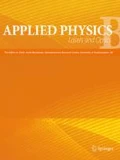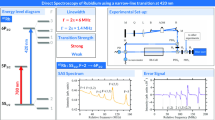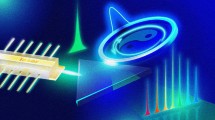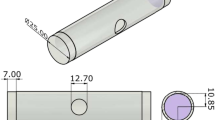Abstract
We report on short pulse generation from a passively Q-switched Pr3+:LiYF4 laser operating at 640 nm. By reducing the cavity length and utilizing Co:MgAl2O4 as the saturable absorber, we obtain the shortest pulse durations from any Q-switched Pr3+ laser. Under pumping with a frequency-doubled optically pumped semiconductor laser at a wavelength of 479.05 nm we realized (8.5 ± 1) ns long pulses at a repetition rate of 0.78 MHz from a 7.5 mm long cavity at an average output power of 1.0 W. In that case, the laser pulse energy and duration were 1.3 µJ and 8.5 ns, respectively. The highest pulse energy amounts to 1.8 µJ at a pulse peak power of 0.19 kW in 9.2 ns pulses at a repetition rate of 0.48 MHz.
Similar content being viewed by others
1 Introduction
Since the first demonstration of diode pumping of a Pr3+-based laser [1], Pr3+-doped laser materials have been shown to be the most efficient solution for the direct generation of visible laser radiation [2]. The green transition at 523 nm and the red transition at 640 nm enable slope efficiencies up to 70% under zero-phonon-line pumping around 480 nm e.g. by frequency-doubled optically pumped semiconductor lasers (2ω-OPSLs) [3] and the recent progress in InGaN-based laser diodes emitting around 445 nm [4,5,6] facilitated continuous wave (cw) output power levels of up to 6.7 W at 640 nm in the red [7].
In recent years, passive Q-switching of Pr3+-doped laser materials has been subject of intensive research utilizing crystalline [8,9,10,11,12] or low dimensional saturable absorber (saturable absorber) materials [13,14,15,16,17]. Low dimensional saturable absorbers typically achieve few-100-ns pulse durations which is at least partially attributed to the low modulation depths in thin-film saturable absorbers. In contrast, crystalline saturable absorbers, in particular Co:MgAl2O4 (Co:MALO) enabled better results. More than 1 W of 640 nm average output power at a high slope efficiency of 47% at ~ 100 kHz pulse repetition rate. 100 ns pulse duration in 10 µJ pulses were obtained under 2ω-OPSL-pumping [9]. Even 2.5 W of average output power in 40 ns pulses under diode pumping [11]. This work also reports the hitherto shortest pulses obtained from any passively Q-switched laser based on Pr3+ as the active ion, amounting 30.9 ns. However, it should be noted that in previous work much longer resonators were utilized and the focus was not on optimizing the pulse duration by reducing the cavity length.
Here, we present the first sub-10-ns pulses of a visibly emitting passively Q-switched Pr3+ laser. In a 2ω-OPSL-pumped linear concave-plane cavity of 7.5 mm length with a Pr3+-doped LiYF4 (YLF) crystal as the active medium and a Co:MALO crystal as the saturable absorber, we obtained shortest pulses of 7.5 ns duration with 0.78 MHz repetition rate at a laser wavelength of 640 nm. At slightly longer pulse durations of 9.2 ns and an average output power of 1.0 W, the pulse energy amounted to 1.3 µJ with a pulse peak power of 0.19 kW. This laser has a great potential for efficient extra- or intracavity frequency doubling into the ultraviolet spectral range. Shorter pulses seem feasible by optimization of the saturable absorber properties.
2 Experimental setup
It is well known that the compact cavity of microchip lasers allows for shortest Q-switched pulse durations [18]. Such microchip lasers are usually operated in a plane-plane cavity configuration with the gain element and the saturable absorber sandwiched between the cavity mirrors.
Pr3+ ions enable efficient laser operation in a true 4-level-laser scheme [19]. The tetragonal host material YLF was shown to be most useful for efficient laser operation based this ion [2, 3]. Its high peak absorption and emission cross-sections in the order of 10–19 cm2 facilitate efficient pump absorption and high gain even for short crystals. The peak absorption in Pr3+:YLF is found for π-polarized pump light, while the highest gain at 640 nm is present in σ-polarization. This requires the use of a-cut samples. Unfortunately, for crystals of this orientation, the interplay between the negative change of the refractive index with increasing temperature [20] and the positive thermal expansion in YLF [21] leads to a strong anisotropy of the resulting thermal lens for σ-polarized light [22], which severely degrades the beam quality of planar microchip cavities based on this material [23].
Consequently, we adopted a cavity incorporating a curved mirror to enable an improved transversal mode control. Despite the low absorption of Co:MALO for the blue pump light, it is useful to place the saturable absorber behind the gain medium in the cavity to avoid any unwanted effects by the pump. Moreover, a smaller laser mode diameter in the Co:MALO saturable absorber than in the Pr3+:YLF gain medium is recommended for stable Q-switching [11, 24]. A near-hemispheric concave-plane cavity combines both [25]. As a further advantage, the cavity length is determined by the radius of curvature of the pump mirror and decoupled from the properties of the output coupling mirrors. Thus, only one set of plane output coupling mirrors is required, even when investigating different cavity lengths.
In the experiments presented here in detail, the radius of the pump mirror was 10 mm and it was highly transparent for the pump wavelength of 479 nm and highly reflective (HR, i.e. T < 0.2%) for the laser wavelength of 640 nm. The plane output coupling mirrors had transmissions T between 2.3 and 10.4% for this wavelength. We utilized a linearly polarized cw 2ω-OPSL (Coherent, Inc.) as the pump source. It features a maximum output power of 5 W at a fixed wavelength of 479.05 nm and a measured beam quality of M2 ≈ 3. To maintain a constant pump beam profile, the pump power was adjusted by a set of a λ/2 plate and a polarizer. The π-polarized pump light was focused into the laser crystal by a lens with a focal length of 50 mm to a focal diameter of 64 µm taking into account the defocusing by the pump mirror. The gain medium was a commercial 5 mm long cylindrical Pr3+:YLF crystal with a diameter of 5 mm (Optogama UAB) and plane parallel, uncoated surfaces. The crystal was held in a water-cooled copper heat-sink and absorbs more than 95% of the pump light. To account for the low segregation coefficient of Pr3+ ions in YLF crystals of 0.22 [26] and the corresponding gradual increase of the doping concentration along the growth axis during the Czochralski-growth of the crystal, we determined the doping concentration in this nominally 0.4 at.% doped sample and found it to be 0.6 at.% by absorption spectroscopy. At this rather high doping concentration the radiative lifetime of ~ 50 µs is reported to be quenched to a fluorescence lifetime of 36 µs [27], but it ensures efficient absorption of the pump light. The 0.75 mm thick Co:MALO serving as the saturable absorber in all experiments characterized in [9] was mounted on a passively cooled aluminum plate and placed between the gain medium and the plane output coupling mirror. It has a small-signal transmission of 93.2% for 640 nm, but the anti-reflection (AR) coating optimized for green has ~ 2% residual Fresnel losses for the red [9]. The optimum cavity length for efficient operation was found to be between 7 and 8 mm.
3 Q-switched laser operation of Pr:YLF
First, we tested the efficiency of the cavity configuration shown in Fig. 1 without the saturable absorber by cw experiments utilizing different output coupling mirrors. The results depicted in Fig. 2a show that it enables high slope efficiencies ηsl around 60% with output coupling mirror transmissions between 2.3 and 10.4% at output powers of up to 2.5 W for the main transition of Pr3+ at a wavelength of 640 nm in diffraction limited beam quality (M2 < 1.1) at the full pump power. These values are below the record values reaching a slope efficiency of 68% for the red transition [3], which we attribute to the onset of quenching effects at the higher doping concentrations investigated here, but also partially to less degrees of freedom in the alignment of the cavity as compared to the results presented in [3].
For the Q-switched laser experiments, we placed the Co:MALO saturable absorber in the cavity as shown in Fig. 1. The radius of the fundamental laser mode inside the saturable absorber varied between 30 µm and 34 µm depending on the cavity alignment and the precise position of the saturable absorber in the cavity. For time resolved measurements, a silicon photodiode DET10A (Thorlabs) with a rise time of 1 ns and a 200 MHz digital storage oscilloscope Tektronix MDO3022 were used. The shortest pulses were also recorded on a 2 GHz oscilloscope (Rohde & Schwarz, RTE1024).
Figure 2b shows the laser characteristics of the Q-switched laser utilizing different output coupler transmissions. Stable Q-switched operation was obtained for all output coupler transmissions under investigation with an average output power of up to 1.0 W for T = 5.7% and 10.4% at slope efficiencies of 26%. In Q-switched operation we found a degradation of the beam quality to M2 values of 3 and 2 along the c- and a-axis, respectively. This indicates the influence of the anisotropic thermal lens in Pr3+:YLF mentioned previously and the stronger heating of the crystal under these conditions.
The pulse duration versus the absorbed pump power is shown in Fig. 3a. The curves show the expected trend of a decreasing pulse duration for increasing pump power. At the highest available pump power, the shortest average pulse durations were found to be 8.5 ns at a transmission of the output coupler of 5.7%. For all lower output coupler transmissions, the pulse durations were also below 10 ns, while the intracavity power at 10.4% output coupler transmission did not allow to fully saturate the saturable absorber, resulting in slightly longer pulse durations of 13.2 ns and an increased standard deviation of the pulse duration of 15% as compared to 10% for all other output coupling mirrors.
We also observed the expected increase of the pulse repetition rate with pump and corresponding output power as shown in Fig. 3b. At the shortest pulse duration of 8.5 ns, the repetition rate amounted 0.78 MHz. The corresponding pulse energy was 1.3 µJ at 0.14 kW peak power. Even higher repetition rates of up to 0.84 MHz were observed utilizing the output coupler with 10.4% transmission for the laser wavelength. Due to the somewhat reduced repetition rate at lower output coupler transmissions, the highest pulse energy of 1.8 µJ and peak power of 0.19 kW were observed for the output coupling mirror with a transmission of 3.5% at an average output power of 0.87 W. The unexpected trend of the repetition rate versus the OC transmission might be related to cross relaxation or other loss processes in highly inverted Pr3+:YLF, but further investigations are required to fully understand this.
In all cases we found the pulse jitter to be significant with a standard deviation of the repetition rate around 20%. This high deviation is partially caused the pulse pattern shown in Fig. 4a. It is clearly visible that the laser operates in a periodically stable operation mode, in which one high peak power pulse is followed by three lower peak power pulses. It should be noted that the temporal resolution of the measurement recorded at a sampling rate of 2.5 GHz is high enough to exclude aliasing effects. Such behavior is supported by the long recovery time of the saturable absorber of 0.7 µs in relation to the pulse separation in the order of 1.5 µs [24]. Thus, we are confident to overcome these instabilities in future by the use of higher saturable absorber modulation depths, resulting in lower pulse repetition rates [18].
a Typical pulse train of the Q-switched laser at a transmission of the output coupling mirror of 5.7% and a pump power of 4.2 W, i.e. average pulse durations of 8.5 ns at 1 W average power. The pulse train was recorded with a sampling rate of 2.5 GHz to avoid aliasing. b Oscilloscope trace of the shortest pulse observed
Figure 4b shows a zoom into one of the highest peak power and thus shortest pulses shown in the oscilloscope trace in Fig. 4a. Its pulse shape is best fitted by a Voigt function, where the slightly asymmetric deviation of the data is attributed to the limited response time of the detector of 1 ns. It should, however, be noted that this can only lead to an overestimation of the pulse duration. The resulting full-width at half maximum (FWHM) pulse duration of 7.5 ns is a factor of 4 shorter than the shortest pulses previously observed in passively Q-switched Pr3+ lasers [11] and even shorter than the pulses obtained in actively Q-switched Pr3+ lasers [23, 28].
To explore the limits of pulse duration shortening by reducing the cavity length, we also tested different cavity lengths, as it is known that the pulse duration of Q-switched oscillators decreases linearly with decreasing cavity length [18, 29]. As can be seen in Fig. 5, in experiments with different radii of curvature of the pump mirrors we found a linear trend.
Nevertheless, according to our results, the extrapolation to zero cavity length does not lead to the expected pulse duration of zero. The reason is, that reducing the radius of curvature of the pump mirror and correspondingly the cavity length inevitably changes the mode radii in the gain medium and the saturable absorber. While the beam radius of the laser mode on the output coupling mirror is ~ 50 µm at a radius of curvature of the pump mirror of 50 mm, it reduces to ~ 30 µm at a radius of curvature of 10 mm. Correspondingly, the pulse fluence in the saturable absorber increases from ~ 1 to ~ 3 J/cm2. This may partly explain why our y-intercept amounts to ~ 4 ns, while calculations [28] and experimental results [30] predict a value of zero. Thus, in our approach a further significant pulse shortening by decreasing the resonator length can only be expected by utilizing saturable absorbers with higher saturation intensity. The increasing fluence also explains the unexpected increase of the repetition rate towards shorter cavity lengths: Previously, we observed a roll-over in the visible transmission of Co2+-doped saturable absorber materials at high fluences [24], which makes it favorable for the laser to operate at increased repetition rates (and thus reduced fluences) to avoid losses. However, more detailed investigations are required to fully explain these observations.
4 Discussion
For Pr3+:YLF it is not straightforward to further reduce the cavity length. As mentioned above, monolithic plane-plane microchip cavities suffer from insufficient or even negative thermal lensing, making the cavity instable. Additionally, the mode diameters in such a configuration would not allow to achieve the intensities required to bleach the Co:MALO saturable absorber material for stable operation [11]. Moreover, a lower limit for the cavity length is given by the required crystal length. In Pr3+:YLF usually below 0.5 at.% doping is chosen to avoid detrimental cross relaxation. Our doping concentration of 0.6 at.% even exceeds this value, and the 5 mm long sample absorbs more than 95% of the pump light. Such a high absorption is beneficial to prevent possible detrimental influence of the residual pump on the saturable absorber. Shorter crystals and thus cavity lengths would come at the expense of a decreased absorption efficiency and higher risk of detrimental effects of the pump in the saturable absorber. Moreover, complicated curved polishing and direct mirror coatings on the crystal surfaces seem required to stabilize shorter resonators and ensure saturation of the saturable absorber.
Further shortening of the pulse duration seems feasible by utilizing saturable absorbers with a higher modulation depth. However, due to their higher insertion losses, increased laser thresholds are expected, which—at the available pump power—would significantly reduce the optical efficiency of our laser. Compensating for this by higher output coupler transmission may result in longer pulse durations—as seen in Fig. 3a—due to insufficient bleaching of the saturable absorber at the corresponding reduced fluences. Pump power scaling, e.g. by replacing our pump source by a high-power InGaN laser diode module, could contribute to overcoming this bottleneck.
5 Conclusion
In conclusion, we presented a compact red-emitting passively Q-switched Pr3+:YLF laser utilizing Co:MALO as the saturable absorber. The 7.5 mm short cavity emits sub-10-ns pulses at hundreds of kHz repetition rate. Due to the high average output power of up to 1 W the pulse energies amount to more than 1 µJ yielding up to 0.19 kW of peak power. We believe that considering the limits of doping concentration and crystal length as well as focusing conditions and saturable absorber transmission, our configuration represents a good compromise between pulse duration and efficiency at the limited available pump power. Shorter pulses appear possible by utilizing thicker or higher doped Co:MALO saturable absorbers, however, these are expected to come at the expense of a significantly reduced average power. Parts of the losses associated with the implementation of the saturable absorber in the cavity could be compensated by AR coatings optimized for 640 nm on all surfaces in the cavity. Our approach has the potential to realize compact and cheap UV sources by external or even intracavity frequency doubling of the 640-nm pulses to 320 nm utilizing LBO (LiB3O5) [26]. Further experiments on Q-switching of Pr3+ lasers operating at other wavelengths in the visible are in progress.
Data availability
The datasets generated during and/or analyzed during the current study are available from the corresponding author on request.
References
A. Richter, E. Heumann, E. Osiac, G. Huber, W. Seelert, A. Diening, Diode pumping of a continuous-wave Pr3+-doped LiYF4 laser. Opt Lett 29, 2638–2640 (2004)
C. Kränkel, D.T. Marzahl, F. Moglia, G. Huber, P. Metz, Out of the blue: semiconductor-laser-pumped visible rare-earth doped lasers. Laser Photonics Rev 10, 548–568 (2016)
P.W. Metz, F. Reichert, F. Moglia, S. Mueller, D.T. Marzahl, C. Kränkel, G. Huber, High-power red, orange, and green Pr3+:LiYF4 lasers. Opt Lett 39, 3193–3196 (2014)
S. Nakamura, M. Senoh, S.I. Nagahama, N. Iwasa, T. Yamada, H. Kiyoku, Y. Sugimoto, InGaN-based multi-quantum-well-structure laser diodes. Jpn J Appl Phys 35, L74–L76 (1996)
S. Nakamura, G. Fasol, S.J. Pearton, The Blue Laser Diode: The Complete Story (Springer, New York, 2000).
S. Nakamura, Nobel lecture: background story of the invention of efficient blue InGaN light emitting diodes. Rev Mod Phys 87, 1139–1151 (2015)
H. Tanaka, S. Fujita, F. Kannari, High-power visibly emitting Pr3+:YLF laser end pumped by single-emitter or fiber-coupled GaN blue laser diodes. Appl Opt 57, 5923–5928 (2018)
R. Abe, J. Kojou, K. Masuda, F. Kannari, Cr4+-doped Y3Al5O12 as a saturable absorber for a Q-switched and mode-locked 639-nm Pr3+-doped LiYF4 laser. Appl Phys Express 6, 032703–032701–032704 (2013)
M. Demesh, D.T. Marzahl, A. Yasukevich, V. Kisel, G. Huber, N. Kuleshov, C. Kränkel, Passively Q-switched Pr:YLF laser with a Co2+:MgAl2O4 saturable absorber. Opt Lett 42, 4687–4690 (2017)
H. Tanaka, R. Kariyama, K. Iijima, K. Hirosawa, F. Kannari, Saturation of 640-nm absorption in Cr4+:YAG for an InGaN laser diode pumped passively Q-switched Pr3+:YLF laser. Opt Express 23, 19382–19395 (2015)
S. Fujita, H. Tanaka, F. Kannari, Intracavity second-harmonic pulse generation at 261 and 320 nm with a Pr3+:YLF laser Q-switched by a Co2+:MgAl2O4 spinel saturable absorber. Opt Express 27, 38134–38146 (2019)
H. Tanaka, R. Kariyama, K. Iijima, F. Kannari, 50-kHz, 50-ns UV pulse generation by diode-pumped frequency doubling Pr3+:YLF Q-switch laser with a Cr4+:YAG saturable absorber. Appl Opt 55, 6193–6198 (2016)
D.D. Wu, Z.P. Cai, Y.L. Zhong, J. Peng, J. Weng, J.Q. Luo, N. Chen, H.Y. Xu, 635-nm visible Pr3+-doped ZBLAN fiber lasers Q-switched by topological insulators SAs. IEEE Photonics Technol Lett 27, 2379–2382 (2015)
S.J. Luo, X.G. Yan, B. Xu, L.P. Xiao, H.Y. Xu, Z.P. Cai, J. Weng, Few-layer Bi2Se3-based passively Q-switched Pr:YLF visible lasers. Opt Commun 406, 61–65 (2017)
Y.J. Cheng, J. Peng, B. Xu, H. Yang, Z.Q. Luo, H.Y. Xu, Z.P. Cai, J. Weng, Passive Q-switching of a diode-pumped Pr:LiYF4 visible laser using WS2 as saturable absorber. IEEE Photonics J 8, 1501606 (2016)
W.S. Li, T.J. Du, J.L. Lan, C.L. Guo, Y.J. Cheng, H.Y. Xu, C.H. Zhu, F.Q. Wang, Z.Q. Luo, Z.P. Cai, 716 nm deep-red passively Q-switched Pr:ZBLAN all-fiber laser using a carbon-nanotube saturable absorber. Opt Lett 42, 671–674 (2017)
W.S. Li, J. Peng, D.D. Wu, H.Y. Lin, Y.J. Cheng, Z.Q. Luo, J. Weng, H.Y. Xu, Z.P. Cai, Orange-light passively Q-switched Pr3+-doped all-fiber lasers with transition-metal dichalcogenide saturable absorbers. Opt Mater Express 6, 2031–2039 (2016)
G.J. Spühler, R. Paschotta, R. Fluck, B. Braun, M. Moser, G. Zhang, E. Gini, U. Keller, Experimentally confirmed design guidelines for passively Q-switched microchip lasers using semiconductor saturable absorbers. J Opt Soc Am B 16, 376–388 (1999)
T. Sandrock, T. Danger, E. Heumann, G. Huber, B.H.T. Chai, Efficient continuous wave laser emission of Pr3+-doped fluorides at room temperature. Appl Phys B 58, 149–151 (1994)
R.L. Aggarwal, D.J. Ripin, J.R. Ochoa, T.Y. Fan, Measurement of thermo-optic properties of Y3Al5O12, Lu3Al5O12, YAIO3, LiYF4, LiLuF4, BaY2F8, KGd(WO4)2, and KY(WO4)2 laser crystals in the 80–300 K temperature range. J Appl Phys 98, 103514 (2005)
O.S. Kazasidis, U. Wittrock, Interferometric measurement of the temperature coefficient of the refractive index dn/dT and the coefficient of thermal expansion of Pr:YLF laser crystals. Opt Express 22, 30683–30696 (2014)
M. Pollnau, P.J. Hardman, M.A. Kern, W.A. Clarkson, D.C. Hanna, Upconversion-induced heat generation and thermal lensing in Nd:YLF and Nd:YAG. Phys Rev B 58, 16076–16092 (1998)
H. Tanaka, Trivalent Praseodymium-Doped Yttrium Lithium Fluoride Visible Lasers Pumped by Gallium Nitride Series Laser Diodes (Keio University, 2018).
H. Tanaka, C. Kränkel, F. Kannari, Transition-metal-doped saturable absorbers for passive Q-switching of visible lasers. Opt Mater Express 10, 1827–1842 (2020)
Y.J. Huang, C.Y. Tang, Y.S. Tzeng, K.W. Su, Y.F. Chen, Efficient high-energy passively Q-switched Nd:YLF/Cr4+:YAG UV laser at 351 nm with pulsed pumping in a nearly hemispherical cavity. Opt Lett 38, 519–521 (2013)
A. Richter, E. Heumann, G. Huber, V.G. Ostroumov, W. Seelert, Power scaling of semiconductor laser pumped praseodymium-lasers. Opt Express 15, 5172–5178 (2007)
S. Sattayaporn, P. Loiseau, G. Aka, D.T. Marzahl, C. Kränkel, Crystal growth, spectroscopy and laser performances of Pr3+:Sr0.7La0.3Mg0.3Al11.7O19 (Pr:ASL). Opt Express 26, 1278–1289 (2018)
H. Tanaka, K. Iijima, Y. Kiyota, F. Kannari, Power scaling, Q-switching and frequency conversion of Pr3+:YLF laser directly pumped by InGaN blue diode lasers, Conference on Lasers and Electro-Optics (ECLEO), Munich, Germany, 2017, pp. CA1.5.
J.J. Degnan, Optimization of passively Q-switched lasers. IEEE J Quantum Electron 31, 1890–1901 (1995)
H. Sakai, H. Kan, T. Taira, >1 MW peak power single-mode high-brightness passively Q-switched Nd3+:YAG microchip laser. Opt Express 16, 19891–19899 (2008)
Funding
Open Access funding enabled and organized by Projekt DEAL. This research was funded by the Leibniz Association.
Author information
Authors and Affiliations
Corresponding author
Ethics declarations
Conflict of interest
The authors have no conflicts of interest to declare that are relevant to the content of this article.
Additional information
Publisher's Note
Springer Nature remains neutral with regard to jurisdictional claims in published maps and institutional affiliations.
Rights and permissions
Open Access This article is licensed under a Creative Commons Attribution 4.0 International License, which permits use, sharing, adaptation, distribution and reproduction in any medium or format, as long as you give appropriate credit to the original author(s) and the source, provide a link to the Creative Commons licence, and indicate if changes were made. The images or other third party material in this article are included in the article's Creative Commons licence, unless indicated otherwise in a credit line to the material. If material is not included in the article's Creative Commons licence and your intended use is not permitted by statutory regulation or exceeds the permitted use, you will need to obtain permission directly from the copyright holder. To view a copy of this licence, visit http://creativecommons.org/licenses/by/4.0/.
About this article
Cite this article
Badtke, M., Tanaka, H., Ollenburg, L.J. et al. Passively Q-switched 8.5-ns Pr3+:YLF laser at 640 nm. Appl. Phys. B 127, 83 (2021). https://doi.org/10.1007/s00340-021-07629-2
Received:
Accepted:
Published:
DOI: https://doi.org/10.1007/s00340-021-07629-2









